blog
“Tributo all’inespresso” by Gian Luca Groppi
Gian Luca Groppi was born in Piacenza and lives and works in Genoa. For more than 30 years he has dedicated himself to photography, mainly in black and white and personally printed in the darkroom. In recent years he has also begun to experiment with digital color. He has been defined by the critic Lorella Klum as “a modern storyteller, who mixes genres and cards, infusing his works with a caustic lyricism that deliberately does not offer panaceas or solutions, but small arrows, to shake us from the widespread social and emotional inertia”. He practices art as a necessity, using his mind and photographic medium to express his poetics: he collects and stages, to reveal and reclaim the ailments, voids and anxieties of society, cloaking them in a saving humor, rather black. He has to his credit several publications and personal exhibitions throughout Europe.
Last May 21st, on the occasion of the “Dieci Giornate della Fotografia” (“ten days of photography”), I had the pleasure of presenting and discussing his work together with him. The meeting developed on the basis of my analysis of the work, to which the photographer added his many anecdotes and his story. With this writing I want to try to summarize, despite its complexity, the artistic production of Gian Luca Groppi. Offer an overview of his main works that is meaningful, without being boring.
At the end of the 90s, fleeing a very restless adolescence, “comforted” by dark culture and music, the author discovers in others the same ailments, emptiness and anxieties that belong to him. The result is his first work, “Neogothic”, in which the photographer is mirrored in his subjects and in their discomfort. But photography is still conceived as a sort of diary: it is not yet used as a real means of expression.
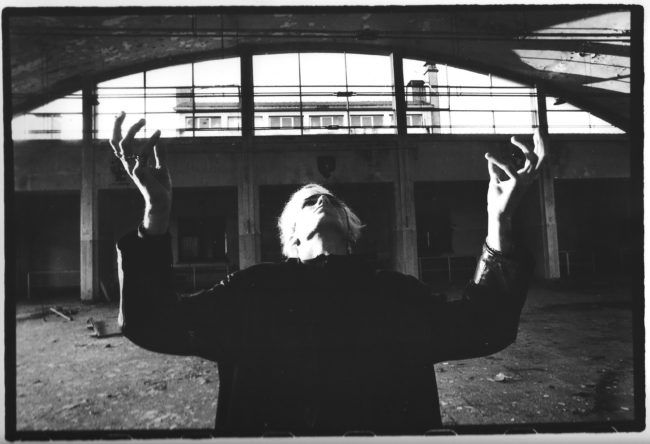
From the project “Neogothic” ©Gian Luca Groppi
Post-adolescent restlessness gives way, in the early 2000s, to an unripe phase, both at a photographic technical level and at a narrative level. It is a period of transition but I find it, however, a piece to add to the story. The author begins to reflect on communication and how to express his thoughts in photography. Between 2001 and 2005 “_I_” was born, which marks the beginning of a sort of personalization, the preamble to a mutation.
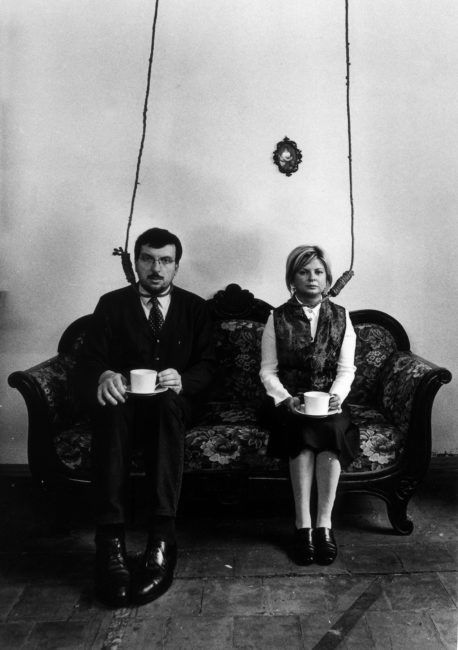
From the project “_I_” ©Gian Luca Groppi
“Mutazioni” (“Mutations”) (2005-2009) is, precisely, the work through which I met Gian Luca of which he himself says:
“Photographs play on linguistic and semantic double meanings; they focus their gaze on the vices, falsehoods and clichés of society, on the compulsion to appear, bringing to light the widespread existential malaise that corrodes energies and values. The characters are decontextualized and reinvented, also through quotations and cultural references. Often anaffective figures emerge from the photographic sets, prey to a communicative entropy that freezes gestures and looks. The brilliant surface of reality loses its glaze and slips towards the territories of illogical surreal logic. Each diptych becomes a reflection, an open story, a behavioral analysis.”
[Gian Luca Groppi]
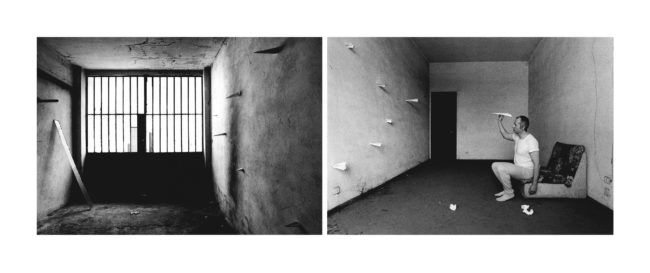
“Stanze” (“Rooms”)
From the project “Mutazioni” (“Mutations”) ©Gian Luca Groppi
This is a work which, regardless of its title, truly corresponds to a mutation. A turning point in which Groppi brings out an aspect that was not so clear in the first works. The early works were part of a vicious circle in which the dark-funereal mood left no room for any optimism; with Mutations a fundamental part of the author emerges: the irony. This is a work in which the real Groppi begins to present himself. The communicative structure in diptychs consolidates. The idea that Groppi’s works are “only children” also consolidates: works that have a life of their own, not closely related to each other. The tones, the scenes, the pairings have a logical thread that makes them coherent, assimilable. Groppi’s evolution is evident and projected towards what, in my opinion, can be defined as maturity which leads, in 2015, to the birth of “Nightmore”.
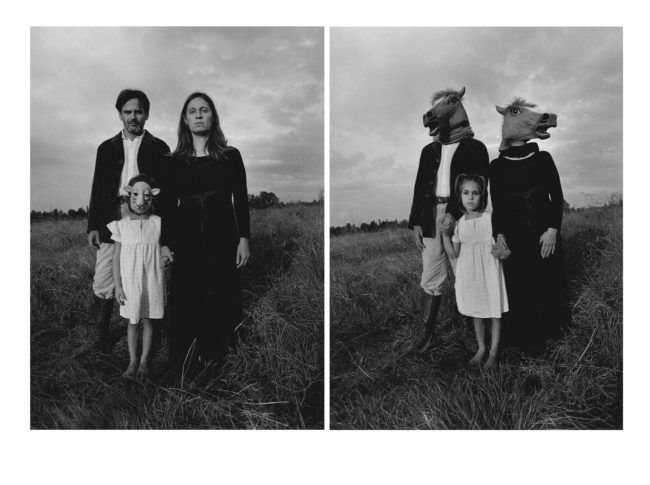
“Imprinting”
From the project “Mutazioni” (“Mutations”) ©Gian Luca Groppi
This work comes after a period of pause, of interruption, of reflection. Black and white, which has always represented a natural component of Groppi’s work, gives way to the first forays into color photography. During these years of pause, the author has developed a predilection for painting and installations, moving away from photography in the classic sense, re-evaluating color as a means of approaching painting and contemporary art. From the black vision of life, devoted only to black and white, he moves on to a vision softened by painting and cinema.
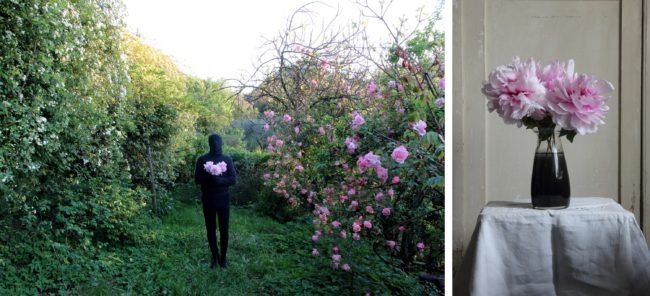
“Black Peonies”
From the project “Nightmore” ©Gian Luca Groppi
“NightMore is one of the latest photographic series he is working on, born in 2015 from the desire to be able to create narratives without the usual meticulous preparation, letting himself be carried away by sensations and dreams. Letting go. The images do not necessarily have a complete meaning, they are suggestions, clues that can lead to different parallel realities. They are situated in that fluctuating state of consciousness which generates illusions and visions. Hypnagogic images received by abandoning oneself to what pre-sleep offers, waiting, without forcing one’s hand.”
[Gian Luca Groppi]

“Miss Hula-Hope”
From the project “Nightmore” ©Gian Luca Groppi
“Nightmore” is an abandonment in which restlessness fades into a sort of balance. A maturity enriched by contact with the culture of the image and, more generally, accompanied by writers, artists and thinkers. Intellectuals who have had a strong influence on his growth and to whom the photographer feels, at a certain point in his career, that he wants to pay homage to those who, among them, ended their existence before their time. In this way, parallel to “Nightmore”, “Tributo all’inespresso” (Tribute to the unexpressed) was born. It is a series of symbolic portraits, which take their cue from parts of the works, lives or even from the moment of death of these artists. The reflection, however, stops not so much on this final act, but, rather, on the double thought of how much this solution has deprived us of their still unexpressed work, making us orphans, and how much, instead, they believed they had nothing more to do say, letting their intelligence and talent be overwhelmed.

“Tribute to Ian Curtis”
From the project “Tributo all’inespresso” ©Gian Luca Groppi
“Tributo all’inespresso”, in my opinion, represents complexity. Lives out of the ordinary and often thorny issues are tackled with serenity. The staging of each shot, rich in detail and imbued with meaning, is approached with a palpable lightness which the author conveys.
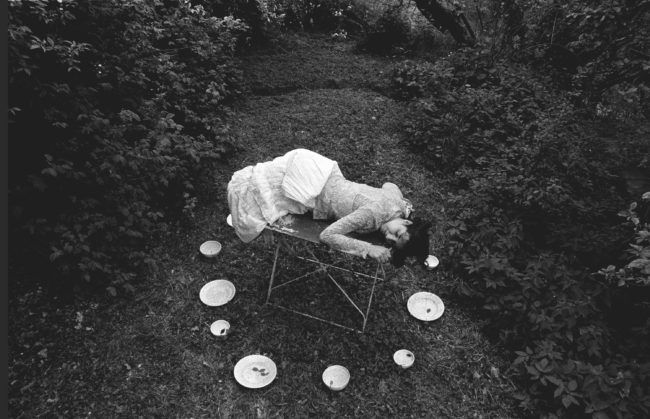
“Tribute to Marina Cvetaeva”
From the project “Tributo all’inespresso” ©Gian Luca Groppi
GianLuca Groppi was part of the “dieci giornate della fotografia” (ten days of photography) because, in an event dedicated to photographic culture, his manifestation between authorial photography and painting, as well as his eclectic and ironic being, was able to interest photographers so such as admirers of visual art in a broader sense. He is a curious, humble, intuitive artist. And his photography has reached a condition where the negative and positive peaks balance each other, making it intense and comfortable. If I had to try to define his photography, especially that of his latest works, it is that of a Dadaism revisited inside a tea room.
I strongly suggest you to follow his artistic production.
The meeting was made possible thanks to the curator Luisa Bondoni and the National Museum of Photography in Brescia.
Gian Luca Groppi
Luisa Bondoni
Museo Nazionale della Fotografia di Brescia
Location: Brescia, Italy Type: Exhibition, Festival, Interview
Events by Location
Post Categories
Tags
- Abstract
- Alternative process
- Architecture
- Artist Talk
- artistic residency
- Biennial
- Black and White
- Book Fair
- Car culture
- Charity
- Childhood
- Children
- Cities
- Collaboration
- Community
- Cyanotype
- Documentary
- Environment
- Event
- Exhibition
- Faith
- Family
- Fashion
- Festival
- Film Review
- Food
- Friendship
- FStop20th
- Gender
- Gun Culture
- Habitat
- Hom
- home
- journal
- Landscapes
- Lecture
- Love
- Masculinity
- Mental Health
- Migration
- Museums
- Music
- Nature
- Night
- nuclear
- p
- photographic residency
- Photomontage
- Plants
- Podcast
- Portraits
- Prairies
- Religion
- River
- Still Life
- Street Photography
- Tourism
- UFO
- Water
- Zine

Leave a Reply